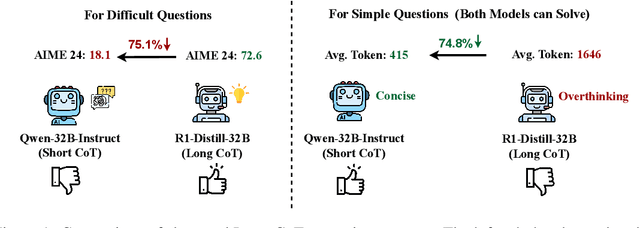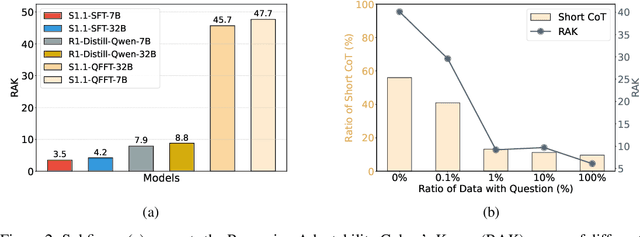Fei Yu
Instructions are all you need: Self-supervised Reinforcement Learning for Instruction Following
Oct 16, 2025Abstract:Language models often struggle to follow multi-constraint instructions that are crucial for real-world applications. Existing reinforcement learning (RL) approaches suffer from dependency on external supervision and sparse reward signals from multi-constraint tasks. We propose a label-free self-supervised RL framework that eliminates dependency on external supervision by deriving reward signals directly from instructions and generating pseudo-labels for reward model training. Our approach introduces constraint decomposition strategies and efficient constraint-wise binary classification to address sparse reward challenges while maintaining computational efficiency. Experiments show that our approach generalizes well, achieving strong improvements across 3 in-domain and 5 out-of-domain datasets, including challenging agentic and multi-turn instruction following. The data and code are publicly available at https://github.com/Rainier-rq/verl-if
HINT: Helping Ineffective Rollouts Navigate Towards Effectiveness
Oct 10, 2025Abstract:Reinforcement Learning (RL) has become a key driver for enhancing the long chain-of-thought (CoT) reasoning capabilities of Large Language Models (LLMs). However, prevalent methods like GRPO often fail when task difficulty exceeds the model's capacity, leading to reward sparsity and inefficient training. While prior work attempts to mitigate this using off-policy data, such as mixing RL with Supervised Fine-Tuning (SFT) or using hints, they often misguide policy updates In this work, we identify a core issue underlying these failures, which we term low training affinity. This condition arises from a large distributional mismatch between external guidance and the model's policy. To diagnose this, we introduce Affinity, the first quantitative metric for monitoring exploration efficiency and training stability. To improve Affinity, we propose HINT: Helping Ineffective rollouts Navigate Towards effectiveness, an adaptive hinting framework. Instead of providing direct answers, HINT supplies heuristic hints that guide the model to discover solutions on its own, preserving its autonomous reasoning capabilities. Extensive experiments on mathematical reasoning tasks show that HINT consistently outperforms existing methods, achieving state-of-the-art results with models of various scales, while also demonstrating significantly more stable learning and greater data efficiency.Code is available on Github.
TAR-TVG: Enhancing VLMs with Timestamp Anchor-Constrained Reasoning for Temporal Video Grounding
Aug 11, 2025Abstract:Temporal Video Grounding (TVG) aims to precisely localize video segments corresponding to natural language queries, which is a critical capability for long-form video understanding. Although existing reinforcement learning approaches encourage models to generate reasoning chains before predictions, they fail to explicitly constrain the reasoning process to ensure the quality of the final temporal predictions. To address this limitation, we propose Timestamp Anchor-constrained Reasoning for Temporal Video Grounding (TAR-TVG), a novel framework that introduces timestamp anchors within the reasoning process to enforce explicit supervision to the thought content. These anchors serve as intermediate verification points. More importantly, we require each reasoning step to produce increasingly accurate temporal estimations, thereby ensuring that the reasoning process contributes meaningfully to the final prediction. To address the challenge of low-probability anchor generation in models (e.g., Qwen2.5-VL-3B), we develop an efficient self-distillation training strategy: (1) initial GRPO training to collect 30K high-quality reasoning traces containing multiple timestamp anchors, (2) supervised fine-tuning (SFT) on distilled data, and (3) final GRPO optimization on the SFT-enhanced model. This three-stage training strategy enables robust anchor generation while maintaining reasoning quality. Experiments show that our model achieves state-of-the-art performance while producing interpretable, verifiable reasoning chains with progressively refined temporal estimations.
AD-AVSR: Asymmetric Dual-stream Enhancement for Robust Audio-Visual Speech Recognition
Aug 11, 2025Abstract:Audio-visual speech recognition (AVSR) combines audio-visual modalities to improve speech recognition, especially in noisy environments. However, most existing methods deploy the unidirectional enhancement or symmetric fusion manner, which limits their capability to capture heterogeneous and complementary correlations of audio-visual data-especially under asymmetric information conditions. To tackle these gaps, we introduce a new AVSR framework termed AD-AVSR based on bidirectional modality enhancement. Specifically, we first introduce the audio dual-stream encoding strategy to enrich audio representations from multiple perspectives and intentionally establish asymmetry to support subsequent cross-modal interactions. The enhancement process involves two key components, Audio-aware Visual Refinement Module for enhanced visual representations under audio guidance, and Cross-modal Noise Suppression Masking Module which refines audio representations using visual cues, collaboratively leading to the closed-loop and bidirectional information flow. To further enhance correlation robustness, we adopt a threshold-based selection mechanism to filter out irrelevant or weakly correlated audio-visual pairs. Extensive experimental results on the LRS2 and LRS3 datasets indicate that our AD-AVSR consistently surpasses SOTA methods in both performance and noise robustness, highlighting the effectiveness of our model design.
Invert4TVG: A Temporal Video Grounding Framework with Inversion Tasks for Enhanced Action Understanding
Aug 10, 2025Abstract:Temporal Video Grounding (TVG) seeks to localize video segments matching a given textual query. Current methods, while optimizing for high temporal Intersection-over-Union (IoU), often overfit to this metric, compromising semantic action understanding in the video and query, a critical factor for robust TVG. To address this, we introduce Inversion Tasks for TVG (Invert4TVG), a novel framework that enhances both localization accuracy and action understanding without additional data. Our approach leverages three inversion tasks derived from existing TVG annotations: (1) Verb Completion, predicting masked action verbs in queries from video segments; (2) Action Recognition, identifying query-described actions; and (3) Video Description, generating descriptions of video segments that explicitly embed query-relevant actions. These tasks, integrated with TVG via a reinforcement learning framework with well-designed reward functions, ensure balanced optimization of localization and semantics. Experiments show our method outperforms state-of-the-art approaches, achieving a 7.1\% improvement in R1@0.7 on Charades-STA for a 3B model compared to Time-R1. By inverting TVG to derive query-related actions from segments, our approach strengthens semantic understanding, significantly raising the ceiling of localization accuracy.
A Two-Stage Lightweight Framework for Efficient Land-Air Bimodal Robot Autonomous Navigation
Jul 30, 2025Abstract:Land-air bimodal robots (LABR) are gaining attention for autonomous navigation, combining high mobility from aerial vehicles with long endurance from ground vehicles. However, existing LABR navigation methods are limited by suboptimal trajectories from mapping-based approaches and the excessive computational demands of learning-based methods. To address this, we propose a two-stage lightweight framework that integrates global key points prediction with local trajectory refinement to generate efficient and reachable trajectories. In the first stage, the Global Key points Prediction Network (GKPN) was used to generate a hybrid land-air keypoint path. The GKPN includes a Sobel Perception Network (SPN) for improved obstacle detection and a Lightweight Attention Planning Network (LAPN) to improves predictive ability by capturing contextual information. In the second stage, the global path is segmented based on predicted key points and refined using a mapping-based planner to create smooth, collision-free trajectories. Experiments conducted on our LABR platform show that our framework reduces network parameters by 14\% and energy consumption during land-air transitions by 35\% compared to existing approaches. The framework achieves real-time navigation without GPU acceleration and enables zero-shot transfer from simulation to reality during
JAM: Keypoint-Guided Joint Prediction after Classification-Aware Marginal Proposal for Multi-Agent Interaction
Jul 23, 2025Abstract:Predicting the future motion of road participants is a critical task in autonomous driving. In this work, we address the challenge of low-quality generation of low-probability modes in multi-agent joint prediction. To tackle this issue, we propose a two-stage multi-agent interactive prediction framework named \textit{keypoint-guided joint prediction after classification-aware marginal proposal} (JAM). The first stage is modeled as a marginal prediction process, which classifies queries by trajectory type to encourage the model to learn all categories of trajectories, providing comprehensive mode information for the joint prediction module. The second stage is modeled as a joint prediction process, which takes the scene context and the marginal proposals from the first stage as inputs to learn the final joint distribution. We explicitly introduce key waypoints to guide the joint prediction module in better capturing and leveraging the critical information from the initial predicted trajectories. We conduct extensive experiments on the real-world Waymo Open Motion Dataset interactive prediction benchmark. The results show that our approach achieves competitive performance. In particular, in the framework comparison experiments, the proposed JAM outperforms other prediction frameworks and achieves state-of-the-art performance in interactive trajectory prediction. The code is available at https://github.com/LinFunster/JAM to facilitate future research.
Robust Brain Tumor Segmentation with Incomplete MRI Modalities Using Hölder Divergence and Mutual Information-Enhanced Knowledge Transfer
Jul 02, 2025Abstract:Multimodal MRI provides critical complementary information for accurate brain tumor segmentation. However, conventional methods struggle when certain modalities are missing due to issues such as image quality, protocol inconsistencies, patient allergies, or financial constraints. To address this, we propose a robust single-modality parallel processing framework that achieves high segmentation accuracy even with incomplete modalities. Leveraging Holder divergence and mutual information, our model maintains modality-specific features while dynamically adjusting network parameters based on the available inputs. By using these divergence- and information-based loss functions, the framework effectively quantifies discrepancies between predictions and ground-truth labels, resulting in consistently accurate segmentation. Extensive evaluations on the BraTS 2018 and BraTS 2020 datasets demonstrate superior performance over existing methods in handling missing modalities.
QFFT, Question-Free Fine-Tuning for Adaptive Reasoning
Jun 15, 2025



Abstract:Recent advancements in Long Chain-of-Thought (CoT) reasoning models have improved performance on complex tasks, but they suffer from overthinking, which generates redundant reasoning steps, especially for simple questions. This paper revisits the reasoning patterns of Long and Short CoT models, observing that the Short CoT patterns offer concise reasoning efficiently, while the Long CoT patterns excel in challenging scenarios where the Short CoT patterns struggle. To enable models to leverage both patterns, we propose Question-Free Fine-Tuning (QFFT), a fine-tuning approach that removes the input question during training and learns exclusively from Long CoT responses. This approach enables the model to adaptively employ both reasoning patterns: it prioritizes the Short CoT patterns and activates the Long CoT patterns only when necessary. Experiments on various mathematical datasets demonstrate that QFFT reduces average response length by more than 50\%, while achieving performance comparable to Supervised Fine-Tuning (SFT). Additionally, QFFT exhibits superior performance compared to SFT in noisy, out-of-domain, and low-resource scenarios.
Automatic Robustness Stress Testing of LLMs as Mathematical Problem Solvers
Jun 05, 2025Abstract:Large language models (LLMs) have achieved distinguished performance on various reasoning-intensive tasks. However, LLMs might still face the challenges of robustness issues and fail unexpectedly in some simple reasoning tasks. Previous works evaluate the LLM robustness with hand-crafted templates or a limited set of perturbation rules, indicating potential data contamination in pre-training or fine-tuning datasets. In this work, inspired by stress testing in software engineering, we propose a novel framework, Automatic Robustness Checker (AR-Checker), to generate mathematical problem variants that maintain the semantic meanings of the original one but might fail the LLMs. The AR-Checker framework generates mathematical problem variants through multi-round parallel streams of LLM-based rewriting and verification. Our framework can generate benchmark variants dynamically for each LLM, thus minimizing the risk of data contamination. Experiments on GSM8K and MATH-500 demonstrate the strong performance of AR-Checker on mathematical tasks. We also evaluate AR-Checker on benchmarks beyond mathematics, including MMLU, MMLU-Pro, and CommonsenseQA, where it also achieves strong performance, further proving the effectiveness of AR-Checker.
 Add to Chrome
Add to Chrome Add to Firefox
Add to Firefox Add to Edge
Add to Edge